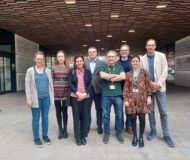

Dr. Eduard Gallardo, a researcher from the Neuromuscular Diseases group at the Sant Pau Research Institute, hosted the “F2F meeting OptiMyG,” a gathering that brought together various professionals to kick off the Characterization and optimization of myasthenia gravis care (OptiMyG) project. The project, coded EJPD AC23_2/00030, was granted to the consortium in the 2023 call for the European Joint Programme on rare diseases. Myasthenia gravis is a rare chronic autoimmune disease that causes weakness and fatigue in voluntary muscles, including those used for eye and eyelid movement. The event took place at the Sant Pau Research Institute on March 14 and 15 with the participation of experts from Sweden, Poland, Switzerland, Italy, Spain, and Finland.
Dr. Gallardo explains that “the project is an initiative of the EJPD Consortium for rare diseases, which includes several countries. The purpose is to contribute to improving the way this disease is treated, establishing protocols for data and sample collection. It is important to share data because it is a rare disease, and with larger samples, it is easier to reach conclusions.”
Currently, there is no consensus or clinical guideline that collects detailed clinical, epidemiological, treatment, and immunological parameter data from various countries for the diagnosis and treatment of myasthenia gravis. “One of the objectives of OptiMyG is to contribute to harmonizing and standardizing criteria to improve the way this rare disease is treated because it has been observed that different countries approach patients somewhat differently.”
During the event, administrative issues such as consortium agreement, ethics, and data management were addressed. Discussions also revolved around the collection of clinical data, both retrospective and prospective, related to myasthenia gravis. Additionally, plans for experimental studies, establishment of timelines, as well as consideration of ethical issues and management and exchange of samples (serum, cells, etc.) were discussed.